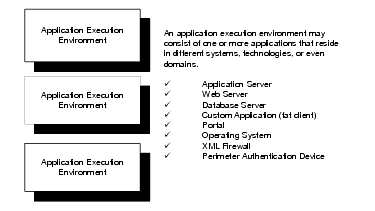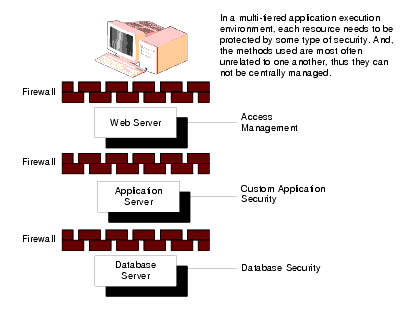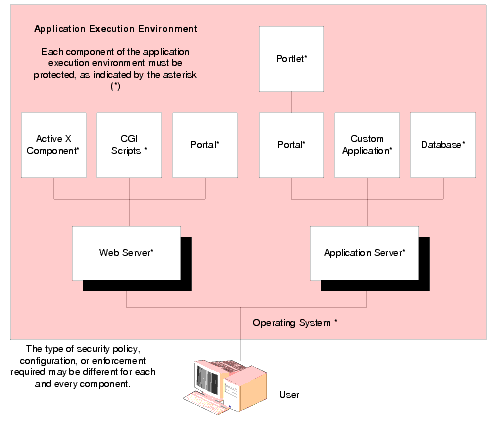









|
This document summarizes the features of the BEA AquaLogic® Enterprise Security™ products and presents an overview of the architecture and capabilities of the security services. It provides a starting point for understanding the family of BEA AquaLogic Enterprise Security products and security infrastructure.
This chapter covers the following topics:
BEA AquaLogic Enterprise Security (ALES) is a fine-grained entitlements engine that allows the user to centrally define and manage policy to control access for both application software components (for example, URLs, EJBs, EJB methods, and so on.) as well as the application business objects (for example, accounts and patients records) that make up the application. Policy is evaluated and enforced locally in the application container so application context can be included as part of the access decision.
A major benefit of ALES as an entitlements engine is that it allows you to remove security logic from the application. Thus, you can take security decisions out of the hands of your developers and define access policy consistently across multiple applications. ALES is also a security infrastructure product that provides a platform for creating a security service layer that can be used by multiple applications. It provides a standard set of security services including authentication, authorization, role mapping, auditing, and credential mapping. The product is distributed in that access decisions are made and enforced at runtime in the application container through a set of Security Service Modules (SSMs).
ALES consists of two major components—the Administrative Server and a set of SSMs. The Administrative Server can be accessed through a browser-based console that you can use to define your users, groups, and roles, the resources in your application, the policies that control access, and the security configurations of the SSMs (see Figure 2-1). ALES also includes Java and Web Services Interfaces that provide administration APIs. You can use these APIs to incorporate ALES administrative functionality into your own applications or even to write your own administrative console. The Administration Server supports delegated administrate in that allows you to delegate administrative functions to other users. Further, it provides a policy analysis function that enables you to analyze your policies to see which policies apply to specific resources, users, groups, and roles. To assist you in defining the access control policies, the Administration Server provides a resource discovery feature that you can use to automatically generate a list of application resources and to create a set of default access policies. Finally, to assist you in transporting your access policies from one Administration Server to another, the Administration Server provides policy exporting and importing tools.

When a security configuration and/or policy is changed, you must distribute it so as to take effect throughout the enterprise, across multiple application execution environments. An open standards-based design allows customers, integrators and vendors to develop and incorporate their own custom security services. And, common security functions can be leveraged by applications throughout the enterprise.
The SSMs plug into the application container and intercept requests, enforce access policies, and make access control decisions in real time. SSMs get updated policy information through a real-time policy distribution mechanism that keeps policy sets up to date and consistent between SSMs. The security framework, the heart of the SSM, provides a set of security services including authentication, authorization, role mapping, auditing and credential mapping. ALES provides SSMs for the BEA WebLogic Platform products and for popular Web servers, such as Microsoft Internet Information Services (IIS) and Apache. Java and Web Services Interfaces are also provided that are language and infrastructure neutral. Applications can invoke the ALES security services directly through either the Java or Web Services APIs. In summary, the ALES SSMs provide the runtime enforcement of policy and a powerful security services layer and can be used as an integration platform for multiple security products in your infrastructure.
The key features of the BEA AquaLogic Enterprise Security product include:
With the rush to build web-based applications and market services over the Internet, many developers had little comprehension of the security issues they may soon confront. Managing security is a huge challenge for any information technology organization that is providing new and expanded services to its employees, customers, and partners through both web-based and legacy applications. The advent of the Internet made protecting information and applications increasingly difficult to manage, monitor, and maintain. Financial transactions (ATM machines, bank transfers, credit card purchases and payments, stock market transactions), personal medical information (implementation of new Health Insurance Portability and Accountability Act or HIPPA regulations), Federal government facilities (Homeland Security affecting both military and civilian) provide only a few examples of areas where the concern for security has become essential and sometimes mandated by law.
Most applications require some form of security. As the complexity and volume of users and resources increases and with the rapid changes in business requirements that continue to evolve, the need for more stringent and robust security technologies becomes evident. To serve a worldwide network of users, an information technology organization must address the fundamental issues of maintaining the confidentiality, integrity and availability of the system and its data, providing the right information, to the right person, at the right time, across a diverse enterprise.
Because these applications often comprise a number of different components that may or may not reside on the same server or even in the same domain, policy management becomes extremely difficult and ensuring enterprise or regulatory compliance can prove impossible.

A typical application execution environment is multi-tiered as shown in Figure 2-3 and may be distributed (vertically or horizontally) between multiple machines running on different operating system platforms. In this case, you must protect each tier or application component. The type of access control and technology for each one may be different and you need to be able to enforce security at each layer.

To address the multitude of potential breaches of security associated with multi-tiered environments, companies have had to purchase and integrate a variety of different and custom security technologies from a host of different vendors:
Integration of security technologies requires the application developer to embed these technologies and hard-code both integrated and unified security requirements within each application. Thus, as the number of applications increases, the expenses associated with application development and maintenance also increases. As a best practice, the application developer should not be responsible for developing, implementing, and managing security requirements.
Early authorization implementations used static and inflexible approaches to define the different types of access granted or denied for a user. Because this type of implementation is extremely time-consuming (if only due to the number of users and the different types of user storage methods in use), it has become impractical for many implementations. Further, the cost of maintaining static first-generation security services can be exorbitant.
BEA has developed an application security infrastructure (ASI) that can be external to and isolated from the application itself. Using a services-oriented, policy-based architecture, you can replace the integrated security silo technologies and hard-coded policies. Figure 2-4 illustrates how a basic application execution environment can be protected using an integrated approach. Each component in the application requires protection, although the type of security typically varies.
A typical information technology environment consists of various types of servers-HTML, proxy, BEA WebLogic, Legacy, J2EE, and application-that access numerous LDAP and database servers containing information such as your user community (name, address, etc.). While the WebLogic platform servers provide application-level security for J2EE components, J2EE-based web services, portal and portlets (EJB, JSP/Servlet, JDNI, JDBC, JMS, MBeans), BEA AquaLogic Enterprise Security provides application security for additional platforms and web servers.

The open flexible architecture of the BEA AquaLogic Enterprise Security products provides advantages to all levels of users and introduces an advanced design for securing your applications. With distributed computing, applications must be integrated across the network, as shown in Figure 2-5. BEA AquaLogic Enterprise Security provides a distributed enterprise security solution that, together with clear and well-documented policies and procedures, can insure the confidentiality, integrity and availability of its applications and data.
Applications across the enterprise are built on a heterogeneous infrastructure with diverse resources. With an application security infrastructure as shown in Figure 2-5, the BEA AquaLogic Enterprise Security products support a fully distributed architecture; integrating all applications across the network.

The BEA AquaLogic Enterprise Security products provide a variety of services that use the AquaLogic security framework, including enhanced policy-based authorization with role mapping, authentication with support for single-sign on and credential mapping, and customizable auditing features. A services-oriented strategy to application security infrastructure improves efficiency and strengthens security by providing a unified and consistent approach across the enterprise. BEA delivers security services that allow third-party security technologies to be exposed as reusable services, to further reduce integration time and costs, promote choice, and insure investment protection.
The type of security services you implement depends on the type of the application component you want to protect. You can use the set of security providers delivered with each Security Service Module to configure and enforce each security service or you can develop custom security providers.
The security services seek to provide ease of use, manageability for end users and administrators, and customizability for application developers and security developers. Administrators who configure and deploy applications can use the security providers included with the product that support most standard security functions or can create custom security providers. The product environments supported include WebLogic Server Versions 8.1 and 9.x, Internet Information Services (IIS) and Apache Web Servers, web services, and Java applications. BEA AquaLogic Enterprise Security will expand this family of Security Service Modules in subsequent releases.
Supports BEA WebLogic Server, Version 8.1 and enhances the existing security services in the application server, providing customizable auditing, multi-domain standards-based single sign-on, database and Microsoft Window NT authentication, database credential mapping, and expanded policy expression capabilities for authorization and role assignments.
The WebLogic Server 9.x Security Service Module integrates AquaLogic Enterprise Security with BEA WebLogic Server versions 9.1 and 9.2.
Supports the IIS Web Server. After installation, the security service module (SSM) binds with the web server through the web server application programming interface (ISAPI) so that the SSM can be used to protect web server application resources.
Supports the Apache Web Server. After installation, the SSM binds the web server through the web server filter so that the SSM can be used to protect web server application resources.
An application programming interface (API) that allows security developers to write custom applications that invoke AquaLogic Enterprise Security services through SOAP. These interfaces support the most commonly required security functions and are organized into services that are logically grouped by functionality.
An application programming interface (API) that allows security developers to develop environment interfaces or even integrate an application security infrastructure into an application. These interfaces support the most commonly required security functions and are organized into services that are logically grouped by functionality.
Each Security Service Module is delivered with a full set of security providers. Table 2-1 lists the types of providers that are available for configuration.
The modular BEA AquaLogic Enterprise Security service architecture provides specific benefits for:
Because most security for web applications and EJBs can be implemented by a system administrator, application developers do not need to be concerned about the details of securing the application, unless there are special considerations that must be addressed explicitly in the code. Security developers can also take advantage of BEA-supplied Application Programming Interfaces (APIs). Three sets of APIs are provided:
com.bea.security package as described in
Javadocs for Java APIs.SSM-SOAP Wsdldocs package as described in
Web Services API Wslddocs.weblogic.security package as described in
Javadocs for WebLogic Security Providers.Administrators can use the security providers supplied as part of the product to implement an integrated solution. Administrators can use the Administration Server to define security roles and assign security policies to resources to create an authorization scheme that suites the needs of their business. In addition, the administrator can modify, test, and deploy the policy quickly and efficiently.
Third-party providers are integrating their products by using the Security Service Provider Interfaces (SSPI). As the underlying integration mechanism for security providers, the SSPI allows development of custom security providers. The SSPIs are available for Adjudication, Auditing, Authentication, Authorization, Credential Mapping, Identity Assertion, and Role Mapping. For information on the SSPIs, see Javadocs for Security Service Provider Interfaces.
This architecture allows security developers to provide integrated solutions that are easy to use. The result is a reduction in development requirements, which means an increased return on investment when implementing an enterprise security management solution. And, custom security services developed for WebLogic Platform 8.1 are compatible with the BEA AquaLogic Enterprise Security services.
A dynamic role-based policy architecture eliminates the need for application developers to design and implement business policy and embed it within each and every instance of an application. More efficient policy administration enables an organization to adapt quickly to dynamic business processes as security policies are designed, tested, deployed, and distributed quickly by security administrators with no coding required.
Delegated administration allows for centralized control and delegated labor, enabling administrators more familiar with the needs of a particular user constituency to implement business policy.
It also allows the implementation of policies across a much larger, more complex, user community with standard policy (for example, consisting of employees, business partners, customers). If a change to a policy is required, it can be distributed throughout the enterprise and take effect whenever desired. With BEA AquaLogic Enterprise Security products, if your application is already written to use some form of authentication or authorization schema, and the schema changes, no changes are required within the application.
BEA AquaLogic Enterprise Security products adhere to the following standards.
This release of AquaLogic Enterprise Security includes the Administration Console and SSM examples shown inTable 2-1.


|